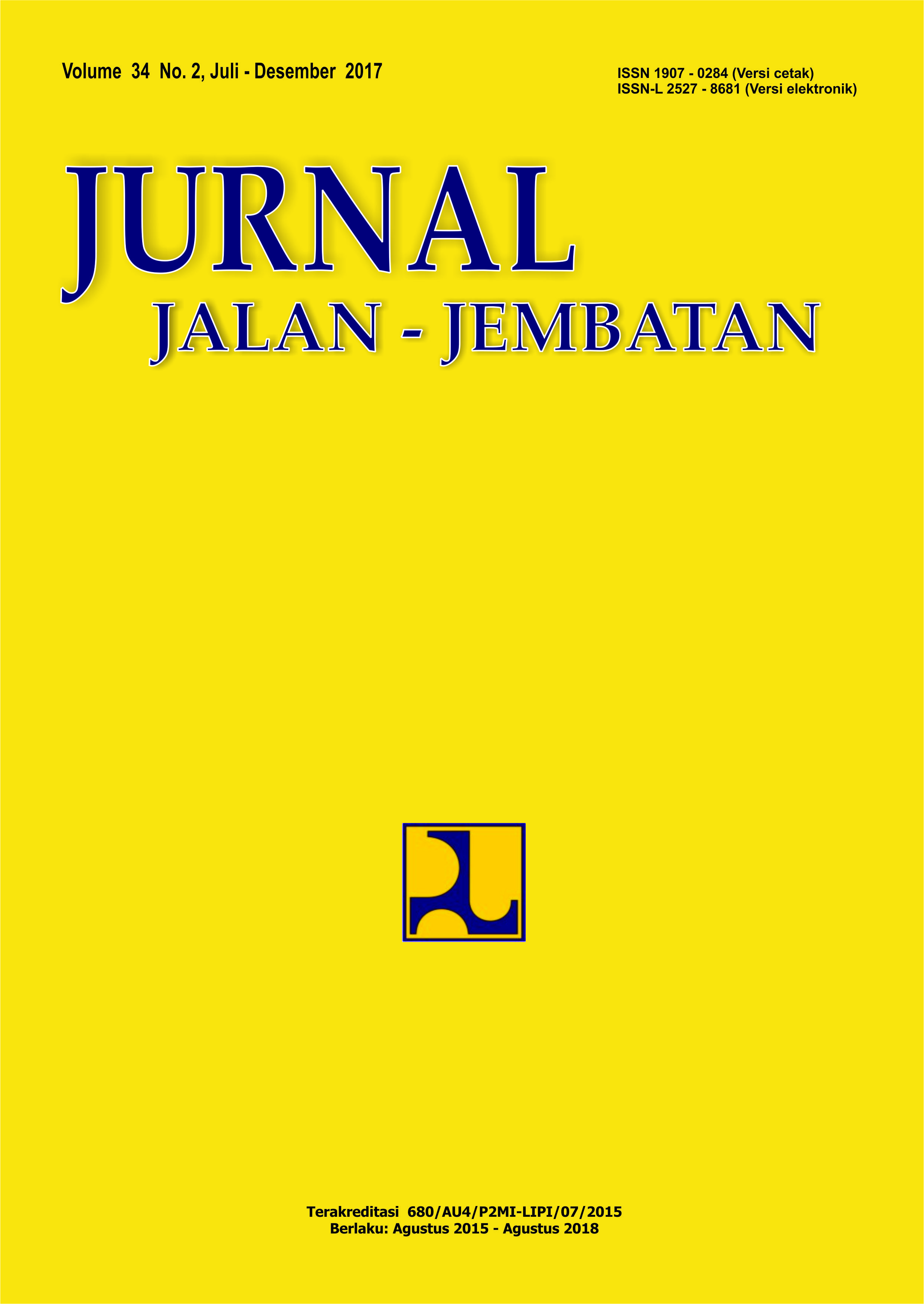PENGEMBANGAN MODEL DEFORMASI PERMANEN UNTUK CAMPURAN STONE MATRIX ASPHALT (DEVELOPMENT OF PERMANENT DEFORMATION MODEL FOR STONE MATRIX ASPHALT MIXTURES )
Main Article Content
Abstract
ABSTRAK
Â
Deformasi permanen atau alur pada jejak roda merupakan jenis kerusakan yang banyak dijumpai dalam perkerasan jalan beraspal, danflow number umumnya digunakan sebagai parameter untuk melihat ketahanan terhadap deformasi permanen. Salah satu jenis perkerasan beraspal yang dikembangkan untuk lebih tahan terhadap alur adalah SMA (Stone Matrix Asphalt). Tujuan dari studi ini adalah untuk mengembangkan model deformasi permanen pada campuran beraspal panas, khususnya pada campuran SMA.  Metodologi yang digunakan adalah metoda experimental yang dimulai dengan pengujian bahan, pembuatan rancangan campuran dan selanjutnya pengujian flow number dengan variasi temperatur pengujian, jenis aspal, rongga udara dalam campuran serta gradasi campuran. Temperatur pengujian digunakan bervariasi dari 20, 35, 45 dan 56 0C. Dua jenis aspal digunakan , yaitu aspal minyak pen 60/70 dan aspal minyak yang dimodifikasi dengan asbuton (aspal batu buton). Hasil studi menunjukkan nilai flow number (ketahanan terhadap alur) akan menurun jika temperatur dan void dalam campuran meningkat, dan flow number akan meningkat jika filler bertambah dalam rentang tertentu. Flow number juga akan meningkat dengan meningkatnya viskositas aspal. Pengembangan model deformasi permanen telah dikembangkan dengan jumlah data sebanyak 32 buah. Persamaan tersebut dibatasi untuk material SMA dengan menggunakan gradasi AASHTO dan untuk beban axial 87 psi (unconfined test). Apabila dibandingkan dengan model deformasi permanen yang telah dikembangkan Rodezno dkk (2010), model ini menghasilkan nilai flow number yang lebih rendah sebagai akibat dari adanya perbedaan dalam pengkondisian contoh uji.
Â
Kata kunci: deformasi permanen, flow number, Â stone matrix asphalt, asbuton
Â
Â
ABSTRACT
Â
Rutting has been considered the most serious distress in flexible pavement, and flow number is an explanatory index for the evaluation of the rutting potential of asphalt mixtures.  One type of asphalt paving are developed to be more resistant to rutting is the SMA (Stone Matrix Asphalt),. The objective of this study was to develop permanent deformation model for hotmixtures, especially for SMA mix. The methodology used in this study is experimental method, its start from material testing, perform design mix and flow number test in some defferent variables such as testing temperature, binder type, mix volumetric and mix grading. The temperature used vary from 20, 35, 45 and 56 0C. Two different binder type was used, i.e. pure petroleum bitumen 60/70 pen grade and pure petroleum bitumen modified by granular Buton rock asphalt (asbuton). The flow number (rutting resistance) of SMA mixture observed in ths study were decreases when the temperature and void in mix increase, and  the flow number will increase if  the increased filler in a certain boundary.  Flow number will also increase with increasing viscosity of asphalt. The development of permanent deformation model has been developed with the amount of data as much as 32 data. The equation should be limited to the SMA mix by using a gradation of AASHTO standard  and axial stress for testing of 87 psi (unconfined test).When compared to the permanent deformation modes that have been developed by Rodezno et al (2010), the model generates value of flow number is lower as a result of the differences in conditioning of the sample.
Â
Keywords: permanent deformation, flow number,stone matrix asphalt, asbuton
Â
Article Details
Authors who publish in this journal agree to the following terms:
-
Authors retain copyright and grant the journal the right of first publication with the work simultaneously licensed under a Creative Commons Attribution License, which allows others to share the work with acknowledgment of the work's authorship and initial publication in this journal.
-
Authors may enter into additional contractual arrangements for the non-exclusive distribution of the journal's published version of the work (e.g., post it to an institutional repository or publish it in a book), with acknowledgment of its initial publication in this journal.
-
Authors are permitted and encouraged to post their work online (e.g., in institutional repositories or on their website) as it can lead to productive exchanges, as well as earlier and greater citation of the published work.
Each submitted manuscript must be accompanied by a "Manuscript Originality Statement" and a "Copyright Transfer Statement".

